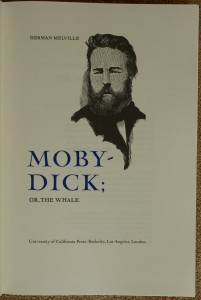 As an Arion Press subscriber, it would be disingenuous to claim that I did not wish that my subscription had begun in 1979 when the press’ leviathan edition of Moby Dick was published. Alas, I was but a senior in high school, and that would have required a literary patron that simply didn’t exist even had I known that Arion Press existed. My subscription started 30 years later, and even though I have had the fortune to fill in a favorite back catalog Arion book here and there, the chances of ever owning their edition of Moby Dick are less than Ahab’s chance of catching the white whale. I was resigned to the trade edition until I lucked upon a copy of the California Deluxe Edition (CDE).
As an Arion Press subscriber, it would be disingenuous to claim that I did not wish that my subscription had begun in 1979 when the press’ leviathan edition of Moby Dick was published. Alas, I was but a senior in high school, and that would have required a literary patron that simply didn’t exist even had I known that Arion Press existed. My subscription started 30 years later, and even though I have had the fortune to fill in a favorite back catalog Arion book here and there, the chances of ever owning their edition of Moby Dick are less than Ahab’s chance of catching the white whale. I was resigned to the trade edition until I lucked upon a copy of the California Deluxe Edition (CDE).
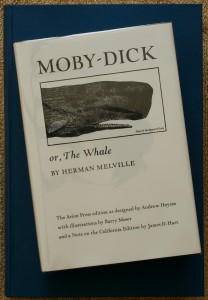 In his Note on the California Edition, James D. Hart, the director of The Bancroft Library, calls the Arion Press edition “the most majestic presentation of America’s most monumental novel.” He continues to explain that the intent of the California Edition was to reach a far larger audience than the Arion Press edition ever could by reducing the scale, thus taking the book “off the lectern for display and puts it in the hands of readers.” Obviously that reduction was accompanied by a reduction in price from the $1000 published price for the original and by opening up the edition run from the 250 done by the Arion Press. Where the AP edition was 15 by 10
In his Note on the California Edition, James D. Hart, the director of The Bancroft Library, calls the Arion Press edition “the most majestic presentation of America’s most monumental novel.” He continues to explain that the intent of the California Edition was to reach a far larger audience than the Arion Press edition ever could by reducing the scale, thus taking the book “off the lectern for display and puts it in the hands of readers.” Obviously that reduction was accompanied by a reduction in price from the $1000 published price for the original and by opening up the edition run from the 250 done by the Arion Press. Where the AP edition was 15 by 10 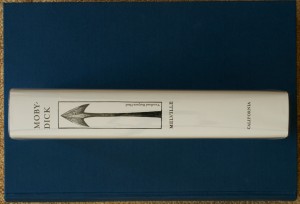 inches, the California Deluxe edition is 14 by 9.75 inches, and the trade edition is 10 by 7 inches. While the Deluxe edition text is printed in black and blue like the original, the trade is all black. The paper used for the CDE is not mentioned but is quite nice. I found a reference that mentioned it being “75-pound beautifully textured paper” but have no idea if that is correct or not. Obviously it does not compare to the special Barcham Green handmade of the original (see my review of the AP Melville’s Selected Poems, which uses the same paper). The paper is scaled back further for affordability in the trade edition.
inches, the California Deluxe edition is 14 by 9.75 inches, and the trade edition is 10 by 7 inches. While the Deluxe edition text is printed in black and blue like the original, the trade is all black. The paper used for the CDE is not mentioned but is quite nice. I found a reference that mentioned it being “75-pound beautifully textured paper” but have no idea if that is correct or not. Obviously it does not compare to the special Barcham Green handmade of the original (see my review of the AP Melville’s Selected Poems, which uses the same paper). The paper is scaled back further for affordability in the trade edition.
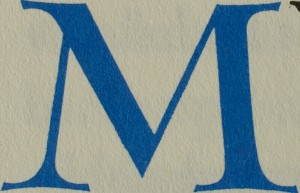 y first read of Moby Dick was maybe 15 years ago in the Easton Press edition. At the time, early in my evolution towards a fine press book lover, the Easton Press treatment WAS fine press to me. So I know I enjoyed the physical book during that read. That book disappeared with many of my books in a nasty divorce (she knew where to stick the proverbial harpoon), leaving me Moby
y first read of Moby Dick was maybe 15 years ago in the Easton Press edition. At the time, early in my evolution towards a fine press book lover, the Easton Press treatment WAS fine press to me. So I know I enjoyed the physical book during that read. That book disappeared with many of my books in a nasty divorce (she knew where to stick the proverbial harpoon), leaving me Moby 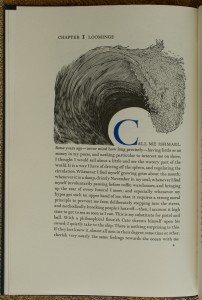 Dick-less for eight years until I bought the AP trade edition, then the CDE a few years later. But I seem to remember being annoyed by all the whaling support material and wanting the story to keep moving. This time I found myself enjoying the whole of the novel much more, maybe because in a re-read I did not feel the urgency of needing to know what happens next. I also picked up on more of the allusions and wisdom in the novel.
Dick-less for eight years until I bought the AP trade edition, then the CDE a few years later. But I seem to remember being annoyed by all the whaling support material and wanting the story to keep moving. This time I found myself enjoying the whole of the novel much more, maybe because in a re-read I did not feel the urgency of needing to know what happens next. I also picked up on more of the allusions and wisdom in the novel.
Ishmael would have been an interesting old salt to talk to in a sea-side tavern, that’s for sure. Melville, as Ishmael, even seems a bit prescient about his fate as an author. At one point, Ishmael muses:
“For small erections may be finished by their first architects; grand ones, true ones, ever leave the copestone to posterity. God keep me from ever completing anything. This whole book is but a draught—nay, but the draught of a draught. Oh, Time, Strength, Cash, and Patience!”
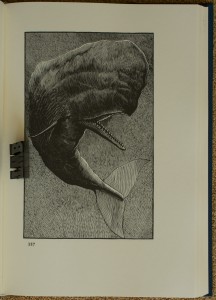 He is talking about his own book on whaling but could easily be talking about Moby Dick. The lackluster public reception of the novel and his later fiction kept the author in financial straights and practically forgotten by his death. It was not until 30 years or so after his death that his reputation as a writer was firmly set in the western canon. Eduardo Galeano in his Memories of Fire trilogy, which I’m currently reading, sums up the popular response to the novel when published as follows:
He is talking about his own book on whaling but could easily be talking about Moby Dick. The lackluster public reception of the novel and his later fiction kept the author in financial straights and practically forgotten by his death. It was not until 30 years or so after his death that his reputation as a writer was firmly set in the western canon. Eduardo Galeano in his Memories of Fire trilogy, which I’m currently reading, sums up the popular response to the novel when published as follows:
“The bearded sailor is a writer without readers. Four years ago he published the story of a captain who pursues a white whale through the seas of the universe, bloodthirsty harpoon in pursuit of Evil, and no one paid it much attention.
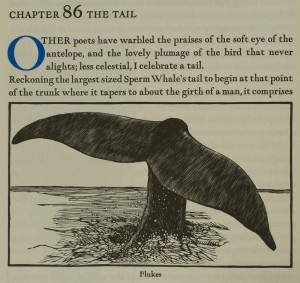 In these times of euphoria, in these North American lands in full expansion, Herman Melville’s voice sings out of tune. His books are mistrustful of Civilization, which attributes to the savage the role of Demon and forces him to play it—as Captain Ahab does with Moby dick in the immensity of the ocean. His books reject the only and obligatory Truth that certain men, believing themselves chosen, impose on the others. His books have doubts about Vice and Virtue, shadows of the same nothingness, and teach that the sun is the only lamp worthy of confidence.”
In these times of euphoria, in these North American lands in full expansion, Herman Melville’s voice sings out of tune. His books are mistrustful of Civilization, which attributes to the savage the role of Demon and forces him to play it—as Captain Ahab does with Moby dick in the immensity of the ocean. His books reject the only and obligatory Truth that certain men, believing themselves chosen, impose on the others. His books have doubts about Vice and Virtue, shadows of the same nothingness, and teach that the sun is the only lamp worthy of confidence.”
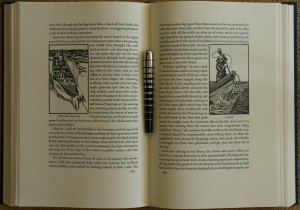 Maybe Melville was prescient about the reception of his writings during his lifetime when he has Ishmael state “I try all things; I achieve what I can.”
Maybe Melville was prescient about the reception of his writings during his lifetime when he has Ishmael state “I try all things; I achieve what I can.”
Much of the novel is spent teaching us about the fearsome power and majesty of the sea. To venture forth onto its bosum is to realize how insignificant man really is. Melville write
“…however baby man may brag of his science and skill, and however much, in a flattering future, that science and skill may augment; yet for ever and for ever, to the 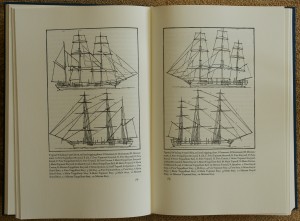 crack of doom, the sea will insult and murder him, and pulverize the stateliest, stiffest frigate he can make; nevertheless, by the continual repetition of these very impressions, man has lost that sense of the full awfulness of the sea which aboriginally belongs to it.“
crack of doom, the sea will insult and murder him, and pulverize the stateliest, stiffest frigate he can make; nevertheless, by the continual repetition of these very impressions, man has lost that sense of the full awfulness of the sea which aboriginally belongs to it.“
And
“Consider all this; and then turn to this green, gentle, and most docile earth; consider them both, the sea and the land; and do you not find a strange analogy to something in yourself? For as this appalling ocean surrounds the verdant land, so in 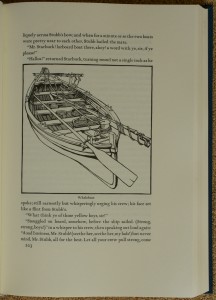 the soul of man there lies one insular Tahiti, full of peace and joy, but encompassed by all the horrors of the half know life. God keep thee! Push not off from that isle, thou canst never return.”
the soul of man there lies one insular Tahiti, full of peace and joy, but encompassed by all the horrors of the half know life. God keep thee! Push not off from that isle, thou canst never return.”
As one sits on a calm ocean rowing far from the whale ship, the sea even starts to lull one into a sense of safety and security as if on a grassy plain, where even Ahab can wax philosophical about it:
“Oh, grassy glades! Oh, ever vernal endless landscapes in the soul; in ye,–though long parched by the dead drought of the earthly life—in ye, men yet may roll, like young horses in new morning clover, and for some few fleeting moments, feel the cool dew of the life immortal on 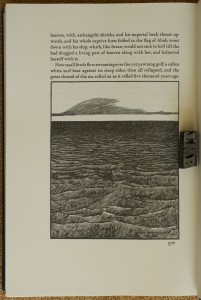 them. Would to God these blessed calms would last. But the mingled, mingling threads of life are woven by warp and woof: calms crossed by storms, a storm for every calm. There is no steady unretracing progress in this life; we do not advance through fixed gradations, and at the last one pause:–through infancy’s unconscious spell, boyhood’s thoughtless faith, adolescence’ doubt (the common doom), then skepticism, then disbelief, resting at last in manhood’s pondering repose of If. But once gone through, we trace the round again; and are infants, boys, and men, and Ifs eternally. Where lies the final harbor, whence we unmoor no more? In what rapt ether sails the world, of which the weariest will never weary? Where is the foundling’s father hidden? Our souls are like those orphans whose unwedded mothers die in bearing them: the secret of our paternity lies in their grave, and we must there to learn it.”
them. Would to God these blessed calms would last. But the mingled, mingling threads of life are woven by warp and woof: calms crossed by storms, a storm for every calm. There is no steady unretracing progress in this life; we do not advance through fixed gradations, and at the last one pause:–through infancy’s unconscious spell, boyhood’s thoughtless faith, adolescence’ doubt (the common doom), then skepticism, then disbelief, resting at last in manhood’s pondering repose of If. But once gone through, we trace the round again; and are infants, boys, and men, and Ifs eternally. Where lies the final harbor, whence we unmoor no more? In what rapt ether sails the world, of which the weariest will never weary? Where is the foundling’s father hidden? Our souls are like those orphans whose unwedded mothers die in bearing them: the secret of our paternity lies in their grave, and we must there to learn it.”
It’s a whole different story when you happen to be dumped from a boat and out of sight of any of you colleagues, as Pip finds out. He’s never the same after they come back to find him and fish him out.
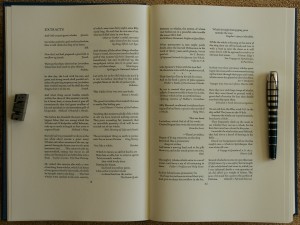 “He saw God’s foot upon the treadle of the loom, and spoke it; and therefore his shipmates called him mad. So man’s insanity is heaven’s sense; and wandering from all mortal reason; man comes at last to that celestial thought, which, to reason, is absurd and frantic; and weal or woe, feels then uncompromised, indifferent as his God.”
“He saw God’s foot upon the treadle of the loom, and spoke it; and therefore his shipmates called him mad. So man’s insanity is heaven’s sense; and wandering from all mortal reason; man comes at last to that celestial thought, which, to reason, is absurd and frantic; and weal or woe, feels then uncompromised, indifferent as his God.”
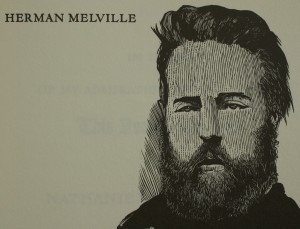 Aside from the epic story of man against nature, whether it is man’s nature, a whale, or the sea itself, there is so much wisdom and intelligence in Melville’s writing. There is darkness in Ahab, Fedallah, and many of the characters as well as in whaling itself. There is also much light in Ishmael’s observations and thoughts as the novel develops. In some ways he seems to be a conscience for the Pequod, reinforced by Starbuck, Queequeg, and little Pip. All
Aside from the epic story of man against nature, whether it is man’s nature, a whale, or the sea itself, there is so much wisdom and intelligence in Melville’s writing. There is darkness in Ahab, Fedallah, and many of the characters as well as in whaling itself. There is also much light in Ishmael’s observations and thoughts as the novel develops. In some ways he seems to be a conscience for the Pequod, reinforced by Starbuck, Queequeg, and little Pip. All 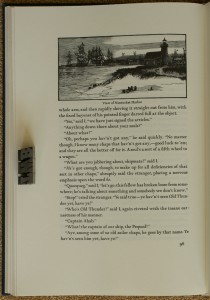 together, the crew gives the Pequod a complex human nature of it’s own, torn by the forces of dark and light as it pursues it goal to its eventual doom. Winner: Moby Dick.
together, the crew gives the Pequod a complex human nature of it’s own, torn by the forces of dark and light as it pursues it goal to its eventual doom. Winner: Moby Dick.
This is definitely a novel I will return to again and again directly through rereading and indirectly through other books like Melville Press’ Cetus and Matt Kish’s Moby Dick in Pictures. It has also sent me searching out other prose and poetry of Melville that I was never aware of when Moby Dick’s spout first appeared on my horizon.
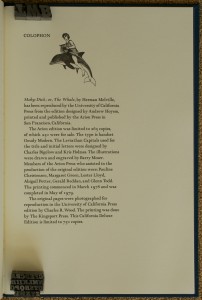 AVAILABILITY: This California Deluxe Edition is limited to 750 copies. Printed in 1981, two years after the landmark Arion Press edition (of 250), and long since sold out. Occasionally available on the secondary market, where I found my copy. The trade edition is available directly from Arion Press and possibly from other booksellers.
AVAILABILITY: This California Deluxe Edition is limited to 750 copies. Printed in 1981, two years after the landmark Arion Press edition (of 250), and long since sold out. Occasionally available on the secondary market, where I found my copy. The trade edition is available directly from Arion Press and possibly from other booksellers.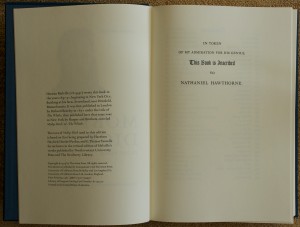

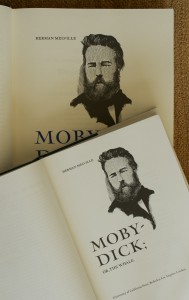
I think this is my favorite post so far! And bravo on the Moby Dick as divorce metaphor quips. “Moby-Dickless” hahahaha
I have Good News and I have Bad News:
The Good News: The California Deluxe Edition of Moby Dick will give you about 75% of the experience of reading the monumental Arion Press edition at a fraction of the price.
The Bad News: The CDE has become nearly as difficult to find on the secondary as the Arion Press original. And similar to the Arion Press ‘Moby Dick’ it has become considerably more expensive. Currently a copy of the CDE in fine condition will cost about $1,000.
The California Deluxe Edition was printed on Curtis Rag paper. (Although I have been unable to find a copy of the CDE and, like you, am unlikely to find myself in a position to spend $10,000 on a copy of the AP edition, I do have the prospectuses for both with which I torment my covetous soul.)